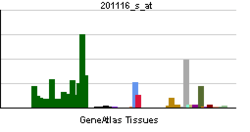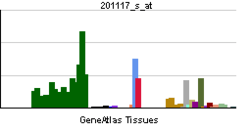Carboxypeptidase E
| View/Edit Human | View/Edit Mouse |
Carboxypeptidase E (CPE), also known as carboxypeptidase H (CPH) and convertase, is an enzyme that in humans is encoded by the CPE gene[3] This enzyme catalyzes the release of C-terminal arginine or lysine residues from polypeptides.
CPE is involved in the biosynthesis of most neuropeptides and peptide hormones.[4] The production of neuropeptides and peptide hormones typically requires two sets of enzymes that cleave the peptide precursors, which are small proteins. First, proprotein convertases cut the precursor at specific sites to generate intermediates containing C-terminal basic residues (lysine and/or arginine). These intermediates are then cleaved by CPE to remove the basic residues. For some peptides, additional processing steps, such as C-terminal amidation, are subsequently required to generate the bioactive peptide, although for many peptides the action of the proprotein convertases and CPE is sufficient to produce the bioactive peptide.[5]
Tissue distribution
Carboxypeptidase E is found in brain and throughout the neuroendocrine system, including the endocrine pancreas, pituitary, and adrenal gland chromaffin cells. Within cells, carboxypeptidase E is present in the secretory granules along with its peptide substrates and products. Carboxypeptidase E is a glycoprotein that exists in both membrane-associated and soluble forms. The membrane-binding is due to an amphiphilic α-helix within the C-terminal region of the protein.
Species distribution
Carboxypeptidase E is found in all species of vertebrates that have been examined, and is also present in many other organisms that have been studied (nematode, sea slug). Carboxypeptidase E is not found in the fruit fly (Drosophila), and another enzyme (presumably carboxypeptidase D) fills in for carboxypeptidase E in this organism. In humans, CPE is encoded by the CPE gene.[3][6]
Function
| Carboxypeptidase E | |||||||||
|---|---|---|---|---|---|---|---|---|---|
| Identifiers | |||||||||
| EC number | 3.4.17.10 | ||||||||
| CAS number | 81876-95-1 | ||||||||
| Databases | |||||||||
| IntEnz | IntEnz view | ||||||||
| BRENDA | BRENDA entry | ||||||||
| ExPASy | NiceZyme view | ||||||||
| KEGG | KEGG entry | ||||||||
| MetaCyc | metabolic pathway | ||||||||
| PRIAM | profile | ||||||||
| PDB structures | RCSB PDB PDBe PDBsum | ||||||||
| Gene Ontology | AmiGO / EGO | ||||||||
| |||||||||
Carboxypeptidase E functions in the production of nearly all neuropeptides and peptide hormones. The enzyme acts as an exopeptidase to activate neuropeptides. It does that by cleaving off basic C-terminal amino acids, producing the active form of the peptide. Products of carboxypeptidase E include insulin, the enkephalins, vasopressin, oxytocin, and most other neuroendocrine peptide hormones and neuropeptides.
It has been proposed that membrane-associated carboxypeptidase E acts as a sorting signal for regulated secretory proteins in the trans-Golgi network of the pituitary and in secretory granules; regulated secretory proteins are mostly hormones and neuropeptides.[7] However, this role for carboxypeptidase E remains controversial, and evidence shows that this enzyme is not necessary for the sorting of regulated secretory proteins.
Clinical significance
Mice with mutant carboxypeptidase E, Cpefat, display endocrine disorders like obesity and infertility.[8] In some strains of mice, the fat mutation also causes hyperproinsulinemia in adult male mice, but this is not found in all strains of mice. The obesity and infertility in the Cpefat mice develop with age; young mice (<8 weeks of age) are fertile and have normal body weight. Peptide processing in Cpefat mice is impaired, with a large accumulation of peptides with C-terminal lysine and/or arginine extensions. Levels of the mature forms of peptides are generally reduced in these mice, but not completely eliminated. It is thought that a related enzyme (carboxypeptidase D) also contributes to neuropeptide processing and gives rise to the mature peptides in the Cpefat mice.
In obesity, high levels of circulating free fatty acids have been reported to cause a decrease in the amount of carboxypeptidase E protein in pancreatic beta-cells, leading to beta-cell dysfunction (hyperproinsulinemia) and increased beta-cell apoptosis (via an increase in ER-stress).[9] However, because CPE is not a rate-limiting enzyme for the production of most neuropeptides and peptide hormones, it is not clear how relatively modest decreases in CPE activity can cause physiological effects.
See also
References
- ↑ "Human PubMed Reference:".
- ↑ "Mouse PubMed Reference:".
- 1 2 "Entrez Gene: CPE carboxypeptidase E".
- ↑ Fricker LD (1988). "Carboxypeptidase E". Annu. Rev. Physiol. 50: 309–21. doi:10.1146/annurev.ph.50.030188.001521. PMID 2897826.
- ↑ Fricker LD (2012). "Chapter 3.5 Carboxypeptidase E". Neuropeptides and Other Bioactive Peptides: From Discovery to Function (Color Version). Morgan & Claypool Life Sciences. doi:10.4199/C00056ED1V01Y201204NPE002. ISBN 1-61504-521-X.
- ↑ Manser E, Fernandez D, Loo L, Goh PY, Monfries C, Hall C, Lim L (Jun 1990). "Human carboxypeptidase E. Isolation and characterization of the cDNA, sequence conservation, expression and processing in vitro". Biochem J. 267 (2): 517–25. PMC 1131319
 . PMID 2334405.
. PMID 2334405. - ↑ Cool DR, Normant E, Shen F, et al. (1997). "Carboxypeptidase E is a regulated secretory pathway sorting receptor: genetic obliteration leads to endocrine disorders in Cpe(fat) mice". Cell. 88 (1): 73–83. doi:10.1016/S0092-8674(00)81860-7. PMID 9019408.
- ↑ Naggert JK, Fricker LD, Varlamov O, et al. (1995). "Hyperproinsulinaemia in obese fat/fat mice associated with a carboxypeptidase E mutation which reduces enzyme activity". Nat. Genet. 10 (2): 135–42. doi:10.1038/ng0695-135. PMID 7663508.
- ↑ Jeffrey KD, Alejandro EU, Luciani DS, Kalynyak TB, Hu X, Li H, Lin Y, Townsend RR, Polonsky KS, Johnson JD (June 2008). "Carboxypeptidase E mediates palmitate-induced beta-cell ER stress and apoptosis". Proc. Natl. Acad. Sci. U.S.A. 105 (24): 8452–7. doi:10.1073/pnas.0711232105. PMC 2448857
 . PMID 18550819.
. PMID 18550819.
Further reading
- Goodge KA, Hutton JC (2000). "Translational regulation of proinsulin biosynthesis and proinsulin conversion in the pancreatic beta-cell". Semin. Cell Dev. Biol. 11 (4): 235–42. doi:10.1006/scdb.2000.0172. PMID 10966857.
- Beinfeld MC (2003). "Biosynthesis and processing of pro CCK: recent progress and future challenges". Life Sci. 72 (7): 747–57. doi:10.1016/S0024-3205(02)02330-5. PMID 12479974.
- Fricker LD, Snyder SH (1982). "Enkephalin convertase: purification and characterization of a specific enkephalin-synthesizing carboxypeptidase localized to adrenal chromaffin granules". Proc. Natl. Acad. Sci. U.S.A. 79 (12): 3886–90. doi:10.1073/pnas.79.12.3886. PMC 346533
 . PMID 6808517.
. PMID 6808517. - O'Rahilly S, Gray H, Humphreys PJ, et al. (1995). "Brief report: impaired processing of prohormones associated with abnormalities of glucose homeostasis and adrenal function". N. Engl. J. Med. 333 (21): 1386–90. doi:10.1056/NEJM199511233332104. PMID 7477119.
- Naggert JK, Fricker LD, Varlamov O, et al. (1995). "Hyperproinsulinaemia in obese fat/fat mice associated with a carboxypeptidase E mutation which reduces enzyme activity". Nat. Genet. 10 (2): 135–42. doi:10.1038/ng0695-135. PMID 7663508.
- Song L, Fricker L (1995). "Processing of procarboxypeptidase E into carboxypeptidase E occurs in secretory vesicles". J. Neurochem. 65 (1): 444–53. doi:10.1046/j.1471-4159.1995.65010444.x. PMID 7790890.
- Hall C, Manser E, Spurr NK, Lim L (1993). "Assignment of the human carboxypeptidase E (CPE) gene to chromosome 4". Genomics. 15 (2): 461–3. doi:10.1006/geno.1993.1093. PMID 8449522.
- Guest PC, Arden SD, Rutherford NG, Hutton JC (1996). "The post-translational processing and intracellular sorting of carboxypeptidase H in the islets of Langerhans". Mol. Cell. Endocrinol. 113 (1): 99–108. doi:10.1016/0303-7207(95)03619-I. PMID 8674818.
- Rovere C, Viale A, Nahon J, Kitabgi P (1996). "Impaired processing of brain proneurotensin and promelanin-concentrating hormone in obese fat/fat mice". Endocrinology. 137 (7): 2954–8. doi:10.1210/en.137.7.2954. PMID 8770919.
- Alcalde L, Tonacchera M, Costagliola S, et al. (1996). "Cloning of candidate autoantigen carboxypeptidase H from a human islet library: sequence identity with human brain CPH". J. Autoimmun. 9 (4): 525–8. doi:10.1006/jaut.1996.0070. PMID 8864828.
- Cool DR, Normant E, Shen F, et al. (1997). "Carboxypeptidase E is a regulated secretory pathway sorting receptor: genetic obliteration leads to endocrine disorders in Cpe(fat) mice". Cell. 88 (1): 73–83. doi:10.1016/S0092-8674(00)81860-7. PMID 9019408.
- Maeda K, Okubo K, Shimomura I, et al. (1997). "Analysis of an expression profile of genes in the human adipose tissue". Gene. 190 (2): 227–35. doi:10.1016/S0378-1119(96)00730-5. PMID 9197538.
- Cain BM, Wang W, Beinfeld MC (1997). "Cholecystokinin (CCK) levels are greatly reduced in the brains but not the duodenums of Cpe(fat)/Cpe(fat) mice: a regional difference in the involvement of carboxypeptidase E (Cpe) in pro-CCK processing". Endocrinology. 138 (9): 4034–7. doi:10.1210/en.138.9.4034. PMID 9275097.
- Lacourse KA, Friis-Hansen L, Rehfeld JF, Samuelson LC (1997). "Disturbed progastrin processing in carboxypeptidase E-deficient fat mice". FEBS Lett. 416 (1): 45–50. doi:10.1016/S0014-5793(97)01164-2. PMID 9369230.
- Utsunomiya N, Ohagi S, Sanke T, et al. (1998). "Organization of the human carboxypeptidase E gene and molecular scanning for mutations in Japanese subjects with NIDDM or obesity". Diabetologia. 41 (6): 701–5. doi:10.1007/s001250050971. PMID 9662053.
- Reznik SE, Salafia CM, Lage JM, Fricker LD (1999). "Immunohistochemical localization of carboxypeptidases E and D in the human placenta and umbilical cord". J. Histochem. Cytochem. 46 (12): 1359–68. doi:10.1177/002215549804601204. PMID 9815277.
- Fan X, Olson SJ, Johnson MD (2001). "Immunohistochemical localization and comparison of carboxypeptidases D, E, and Z, alpha-MSH, ACTH, and MIB-1 between human anterior and corticotroph cell "basophil invasion" of the posterior pituitary". J. Histochem. Cytochem. 49 (6): 783–90. doi:10.1177/002215540104900612. PMID 11373325.
- Friis-Hansen L, Lacourse KA, Samuelson LC, Holst JJ (2001). "Attenuated processing of proglucagon and glucagon-like peptide-1 in carboxypeptidase E-deficient mice". J. Endocrinol. 169 (3): 595–602. doi:10.1677/joe.0.1690595. PMID 11375130.
External links
- The MEROPS online database for peptidases and their inhibitors: M14.005
- Carboxypeptidase E at the US National Library of Medicine Medical Subject Headings (MeSH)

